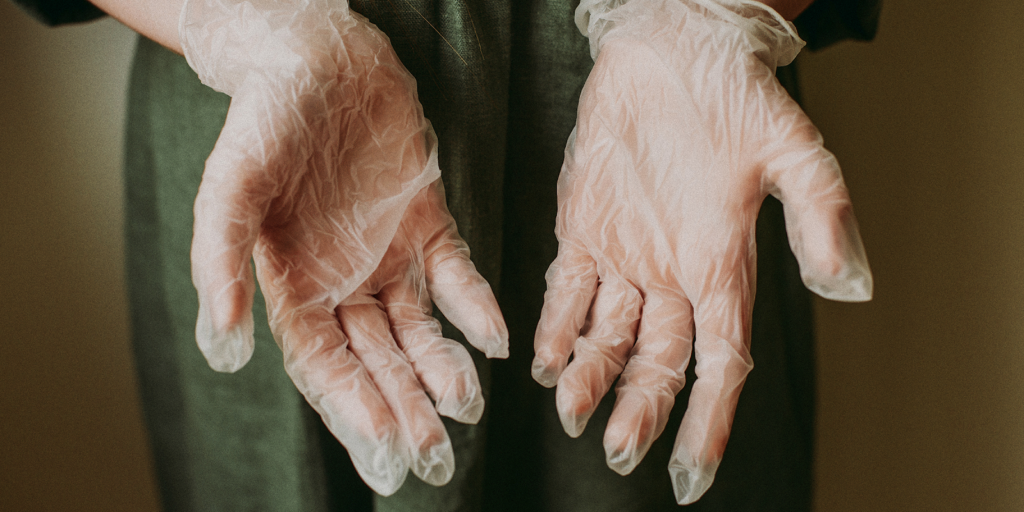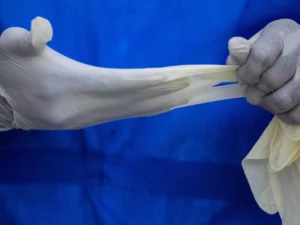In many sectors, disposable gloves are useful and often necessary, but just like with any equipment or supply, there are recommended practices that you should adhere to get the most use out of your gloves while optimizing barrier protection.
Here are the top seven guidelines for using disposable gloves.
1) Start by washing your hands
Even though it may seem paradoxical, cleaning your hands prior to donning gloves is essential for maintaining good hand hygiene.

After all, if you don’t wash your hands beforehand, you can unintentionally contact the glove surfaces with bare hands and infect them. In addition, if the gloves rip for any reason, you might transfer germs.
Follow the guidelines provided by the U.S. Centers for Disease Control and Prevention (CDC) for good handwashing techniques:
- Wash your hands with soap and clean, cold, or warm, running water before turning off the faucet.
- Rub the soap on your hands to create a lather. Make sure to wash the underside of your nails, the backs of your fingers, and the backs of your hands.
- Spend at least 20 seconds cleaning your hands. Require a timer? Chant “Happy Birthday” twice, starting to finish.
- Thoroughly wash your hands with clean, running water.
- Dry your hands with a fresh towel or let them air dry.
2) Scan your gloves for rips, holes, punctures, or cracks before putting them on
Before using your gloves, give them a once-over. Are any pinholes visible? Cracking? Discoloration? Throw away those gloves and choose a different pair if you notice any of them.
A general guideline for glove use is: It’s always better to be safe than sorry.
3) If your gloves seem to be deteriorating, get a new pair.
It’s time to switch to a new pair of gloves if you see any symptoms of wear. The more disposable gloves you wear, the better is another adage to live by. In the field of glove safety, less is not always better.
4) Disposable gloves shouldn’t be washed or used again
There is a reason why disposable gloves are just that. They are not meant to be reused; rather, they are made for brief use. If in doubt, just grab a different set of gloves.

5. Use the proper-sized gloves
In addition to the quality of the glove, the size of the disposable gloves you wear is also crucial. The integrity of their application(s) may be jeopardized if your gloves don’t fit the size of your hands. Additionally, you can have hand tiredness, lose your gloves, and experience less protection from them.
The ideal gloves to pick are those that snugly fit your hand without being uncomfortable. You want comfort as well as a tight fit.
6) Wash your hands after changing gloves
Once again, washing your hands is one of the most crucial and efficient strategies to stop the transmission of illness and pollution. Wash your hands first before putting on fresh gloves anytime you toss away a pair.
7) Are you allergic to latex? Instead, choose gloves made of cast polyethylene (CPE), vinyl, or nitrile
Looking to use the best disposable gloves? Look for gloves made of other materials if you have ever had a latex allergy or even just the slightest inkling that you could. Gloves made of nitrile, vinyl, or/and CPE are suitable alternatives to latex gloves.

You could be experiencing an allergic response to latex if you have any of the following symptoms: dry, itchy, crusty skin with cracks or sores; runny nose; wheezing; trouble breathing; swelling of the face; cramps; and shock. The best course of action will be to choose the alternate choice in such a situation.
In order to prevent infection, minimize cross-contamination, and maintain a high standard of safety and hygiene in the workplace, disposable gloves are necessary for a variety of sectors.
To lessen the chance of ripping and undoing the protection they provide, disposable gloves must be carefully put on and worn.
To help you do jobs safely and at the least possible risk, Brosch Direct explains how to put on disposable gloves in this article. This detailed explanation should make workplace events less likely to happen and guarantee that your company is protected. Click here to read about How disposable gloves can ensure your safety while performing your job?
How to put on disposable gloves
Check the glove size in step one
The size of the gloves you are going to do is quite significant. If they are the right size, they won’t be too tight and tear or too loose and fall off or limit dexterity. Manufacturer-specific glove sizing varies, but we have a terrific guide to help you figure out which size you’ll probably need.
Remove all jewelry
Disposable gloves may get caught on bracelets and rings with big stones, tearing and breaking them. Before putting on the gloves, take them off.
Ensure Clean Hands
Although you may believe the gloves are the primary form of protection, it’s crucial to keep your hands clean as well so that, in the event of a tear or rupture, the skin below is still clean to prevent the spread of diseases.
On this website, you can get comprehensive advice on how to wash your hands properly. Antibacterial hand gel will do in the absence of soap and water.
Before putting on disposable gloves, make sure that your hands are completely dry.
Remove the gloves from their packaging
Before putting them on, thoroughly inspect them for any evidence of rips or tears to make sure they are in excellent condition.
Start using your dominant hand
It’s a good idea to cover your dominant hand first. To accomplish this, take up the glove by the inside of the sleeve with your non-dominant hand. Next, just insert your strong hand inside this.
To avoid the risk of contamination, always only touch the inside of the glove, and only adjust this glove once the other one is on.
Put on the other glove
Push your non-dominant hand into the opening and slowly slide it inside while holding the glove by the sleeve once again. Make cautious not to overextend your fingers until they are in their proper holes.
Gloves Adjustment If Required
Carefully reposition the gloves so that they properly enclose the whole hand and fit the fingers. To minimize rips and tears, be careful not to pull too hard while adjusting the glove’s cuff. Also, avoid contacting the flesh on your wrist. You can also read about Correction to: A design framework for a seamless smart glove using a digital knitting system by visiting https://fashionandtextiles.springeropen.com/articles/10.1186/s40691-021-00253-w


